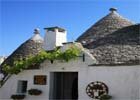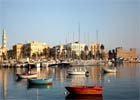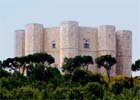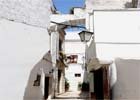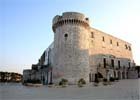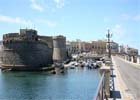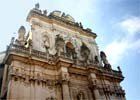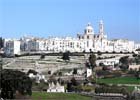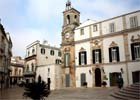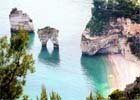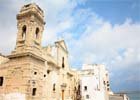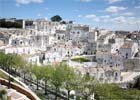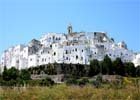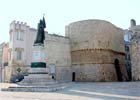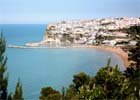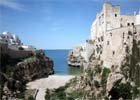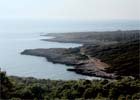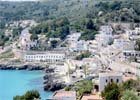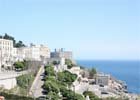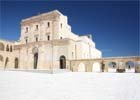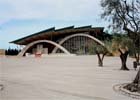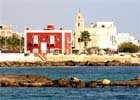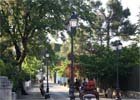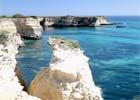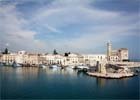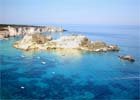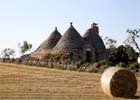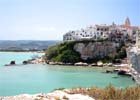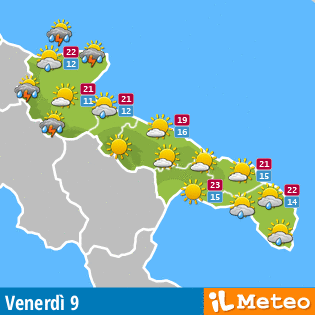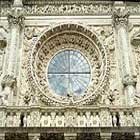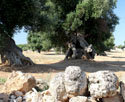Places to be visited
Apulia: a mix of sea, nature, art, culture and pleasures of the table
The Apulian region is characterized by its great charm given by the perfect mix of sea, nature, art, culture and pleasures of the table. It has attractions to suit every taste, from the very long coast with its beautiful cliffs marked by different forms to the wonderful golden beaches with their crystal clear waters. From the valuable Barocco of Lecce to the countless castles and churches built during different times following various tastes: these are the traces of many civilizations that inhabited these places. Ancient maritime centres alternate with others characterized by lime painted buildings and narrow alleys awakening the tourist’s curiosity, without forgetting the typical cone-form buildings called trulli.
Alberobello, a set of Trulli which became a U.N.E.S.C.O. World Heritage Site
Alberobello is a really singular city thanks to its trulli, which are famous all over the world. They are dry-stone buildings characterized by white lime walls and grey stones used to realize the typical cone-form roofs. The town expands on two hills; the first lies east and includes the modern part of the city; the second lies west and there we find the quarters Monti and Aia Piccola, which represent the monumental area marked by the trulli.
Bari is the largest and economically most important city on the Adriatic sea
The city of Bari is the chieftown of Apulia and it appears as a very rich and dynamic town. It is the ninth most-populated city in Italy and the third most important city of Southern Italy after Naples and Palermo. It was founded by Illyrians and then became a roman city being a strategic centre on the Via Traiana; subsequently it was under the dominance of Longobards, Arabians and Bizantynes until the Norman conquest.
An octagonal castle framed by eight octagonal towers
The castle known as “del Monte” is famous all over the world thanks to its unique octagonal form and its eight towers which show an octagonal form too. The mansion was built by Emperor Federico II di Svevia, between 1229 and 1249, probably as hunting palace. When the Swabian dynasty fell, the castle was used as prison.
Cisternino, a total white village surrounded by alleys, arches, stairs and balconies full of flowers
It is easy to get lost in the centre of this total white village, in a network of alleys, arches, stairs and balconies full of flowers, which is the result of the spontaneous architecture marking this town. The village overlooks the Valle d’Itria or Valle dei Trulli from a wonderful balcony and it is mentioned in the list of the most beautiful towns in Italy.
Conversano, a medieval village on the Murge
Conversano, with its little medieval suburb, lies on the first hills of the Murge; it was already peopled during the Prehistoric Age by Peuceti and Japigi and it is possible to find an evidence of their passage in the ruins of the megalithic walls surrounding the ancient Norba, which can be perfectly admired near the abbey of San Benedetto and at the base of the main tower of the castle.
The enchanting old town centre of Gallipoli standing on an island
Kalé polis, the beautiful city. This is the name the Greeks gave it. Gallipoli is sited along the west coast of the Salento peninsula; it overlooks the Ionian sea and appears divided into two different parts that is to say the suburb and the old town centre, which are bound together by a 17th - century stone bridge with seven spans.
Lecce, the city of Baroque
Lecce, the city of Baroque, is famous all over the world thanks to its really valuable Baroque which is its distinguishing mark; its splendour is due to the intuition of emperor Carlo V, who provided the city with new defensive structures against the Turks and promoted the artistic development which made the city win the name Firenze del Sud (“the Florence of southern Italy”).
Locorotondo, a village immersed in the beautiful Valle d’Itria
It is a village standing on the top of an hill in the beautiful Valle d’Itria. It is possible to admire the view from the municipal villa but it is also interesting to venture in the narrow alleys of the suburb and admire the ancient buildings made of white lime. The name of the town comes from the concentric position of its streets.
Martina Franca one of the most elegant city in Apulia
One of the most elegant city in Apulia, close to the south-eastern area of the Murge, Martina Franca appears as an ancient town marked by narrow alleys and popular courtyards, where it is beautiful to venture and admire the beauties of its Baroque. The elegance of its architecture makes the city precious; the Baroque style is everywhere: in the palaces, the portals, the windows, the balconies and their railings.
Mattinata: sea, mountains and a wonderful view
The town of Mattinata stands on the central-southern side of the Gargano promontory. Sea and mountains characterize this territory, where it is possible to admire golden beaches, clean cliffs, hilly pastures, Aleppo pine, holms and oak woods. Here we find the most typical aspects characterizing the area of the Gargano National Park.
Monopoli and its suggestive and lively old town centre
Situated on the sea and surrounded by old Messapic walls which date back to the 5th century B.C., Monopoli is one of the most important ports in the Adriatic sea and it is characterized by a very lively old town centre. With its suggestive and characteristic atmosphere, it dates back to Early Middle Ages; it was built on the ruins of an important Messapic town.
The old town centre of Monte Sant'Angelo develops around the Archangel’s cave
Monte Sant’Angelo stands on a 800 metres high rocky spur of the Gargano and it is a U.N.E.S.C.O. World Heritage Site; it develops in the 5th century A.D. and it is indissolubly linked with the cult of Saint Michael, the Archangel. According to the tradition, the Archangel appeared in a cave in 490, 492, 493, to Lorenzo, Bishop of Siponto.
Ostuni, the white town kissed by the sun
Ostuni, famous as the “white town” because of its bright white lime walls, stands on an hill which dominates the sea, at the end of the southern Murgia. It is beautiful with its white little houses, the courtyards and the alleys surrounded by ancient walls with Aragonese towers.
Otranto, the most eastern city of Italy. Great charm and ancient origins
It is the most eastern city of Italy, with extraordinary charm and ancient origins. The area of Otranto was probably already peopled during the Paleolithic age. Subsequently it was inhabitated by Messapi, Greeks and Normans. Thanks to its strategic geographical position, it was an important trading, politic and religious centre, especially during the Byzantine and Norman period, being a sort of bridge between East and West.
Peschici, a characteristic old town centre on a promontory
Peschici was founded around the year one thousand, when Dalmatians and Schiavoni settled here to stem Saracen raids. It shows a characteristic old town centre, on a 90 metres high promontory falling sheer to the sea it is possible to admire the white single-storey houses and the dome-shaped roofs following the Arabian style.
Polignano a Mare stands on a cliff falling sheer to the Adriatic sea
On the top of a cliff that falls sheer to the sea being 24 metres high in the highest point, stands the old town of Polignano, where the coast is characterized by erosive phenonema and inlets. It has Greek origins but some scholars assert that it was already peopled during the prehistoric age.
Porto Selvaggio, Regional Natural Park
Porto Selvaggio belongs to the territory of Nardò and it has been declared protected area and Regional Natural Park in 1980. The protected area extends over 420 hectares, for the greatest part covered by woods. It is worth mentioning the presence of the wonderful Mediterranean maquis with alternate imposing falaises, sheer to the sea.
San Pietro In Bevagna
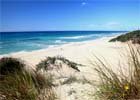
Castro marina, a village of fishermen at the feet of the medieval city
Castro marina is well known for its crystal waters and its main attraction is surely represented by the sea caves which are situated in the northern area of the town. During the Hellenic domination (4th century B.C.) the zone was used as extractive cave; it is during the Middle Ages that it became a little rocky centre with its small port.
Santa Cesarea Terme, an ancient thermal place
It is a famous thermal place developed in the 1920s but it was already known in antiquity thanks to the presence of sulphureous thermal waters. They gush out of four caves (Gattulla, Solfatara, Fetida, Sulfurea). According to the myth these sources are linked with the birth of four Leuterni giants, killed by Hercules with strokes of club
Santa Maria di Leuca is the farthest end of Salento
Romans called it “De Finibus Terrae”. Santa Maria di Leuca is the farthest end of Salento, the “heel” of Italy, point of contact between the Adriatic Sea and the Ionian Sea.On the top of the promontory, dominating the coast, stands the Basilica-Sanctuary of Santa Maria de Finibus Terrae, ancient place of pilgrimage.
The story of this city is deeply linked with that of Father Pio from Pietrelcina
San Giovanni Rotondo lies in a valley, 600 metres in height, in the Gargano promontory and it is famous all over the world thanks to the charismatic Saint Pio from Pietrelcina, who draws thousands of believers. San Giovanni Rotondo dates back to the 11th century when in a little village stood a round baptistery dedicated to San Giovanni.
Savelletri a little maritime village
It is a little maritime village with beautiful crystal clear waters, on the coast road between Monopoli and Fasano; it is well known thanks to its sandy beaches with alternate rocky areas. Savelletri is also famous for its marine: in its port it is possible to moor nearly 300 boats.
Selva di Fasano, a beautiful holiday resort
At 400 metres above the sea-level, on the pre-murgia, halfway between the valle dei trulli and the sandy beaches of the coast road, the Selva di Fasano has represented a well-known holiday resort since the end of the 19th century.The area is also embellished by elegant villas, some of which with very ancient origins.
Torre dell'Orso, dunes and beaches alternate with high cliffs
On the coast road between San Cataldo and Otranto, the territory offers an extremely interesting natural panorama, with dunes and beaches alternate with high cliffs. The name Torre dell’Orso comes from the presence of a 16th – century sighting tower, today in ruins.
Trani, a casket full of historical, artistic, religious and cultural treasures
Trani surely represents one of the most beautiful destinations of our Region, a casket full of historical, artistic, religious and cultural treasures. It is famous not only for its wonderful cathedral, on the sea, but also for the imposing castle and the elegant town.
Tremiti islands, an archipelago of uncontaminated nature
It is an archipelago of uncontaminated nature, 22 km out to the coast of Gargano, which is formed by three main islands: San Nicola, San Domino and Capraia, to which we add the little island of Cretaccio and the farther Pianosa. These islands are also called Diomedee because the myth says that, after the Trojan war, the hero Diomede had been buried exactly here.
Trulli and dry walls among vineyards, olive trees and groves
The Valle d’Itria it is a sweet countryside characterized by dry walls, where olive trees and vineyards alternate with oak tree groves, and by the typical trulli, scattered here and there. This natural masterpiece includes some of the most beautiful and characteristic towns of Apulia, such as Martina Franca, Alberobello, Locorotondo and Cisternino, very interesting destinations.
Vieste the old town centre is really charming
The town of Vieste is the main centre of the Gargano; it is particularly famous for its beautiful waters. The old town centre is really charming: it is characterized by typical white houses and narrow alleys leading to little squares. The upper part of the town stands on the part of the promontory known as Punta San Francesco, marked by a fortified monastery and the Norman-Swabian castle.

 Home PUGLIA
Home PUGLIA Places to visit
Places to visit Sea places
Sea places Ancient villages
Ancient villages Salento
Salento Gargano
Gargano Tremiti Islands
Tremiti Islands Valle D'Itria
Valle D'Itria Lecce Baroque
Lecce Baroque Holy sites
Holy sites Olive groves
Olive groves Sitemap
Sitemap